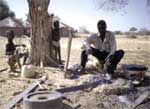


"Population growth and increase in food demand will drive expansion and intensification of cultivated lands. If unchecked, desertification and degradation of ecosystem services in drylands will threaten future improvements in human well-being and possibly reverse gains in some regions."
In order to better understand the consequences of different development and management options, the Millennium Ecosystem Assessment developed four scenarios that explore the future of desertification and human well-being in drylands until 2050 and beyond.
The four plausible scenarios explored in this assessment consider two possible paths of world development: increasing globalization or increasing regionalization. The scenarios also consider two different approaches to environmental issues: in one approach, actions are reactive and address problems only after they become obvious, in the other approach, ecosystem management is proactive and deliberately aims for long-term maintenance of ecosystem services.
The four scenarios are:
| World Development | |||
|---|---|---|---|
| globalization | regionalization | ||
| Ecosystem Management | reactive |
 Global Orchestration |
 Order from Strength |
| proactive |
 TechnoGarden |
 Adapting Mosaic | |
In all four scenarios, the desertified area is expected to increase, though not at the same pace. Poverty and unsustainable land use practices will continue to be the main factors driving desertification in the near future. The relief of pressures on drylands is strongly linked to poverty reduction. Under all four scenarios, population growth and increase in food demand will drive an expansion of cultivated land, often at the expense of woodlands and rangelands. This is likely to increase the extent of desertified land. None of these scenarios foresees a reversal in the threat of desertification.
In all these scenarios, climate change is linked to desertification, but its impacts vary depending on the region and the management approach adopted. Climate change is expected to affect the global water cycle and local precipitation trends. It is likely that extreme weather events in drylands will further intensify, bringing more floods and more droughts.
The two management approaches:
Proactive management approaches are likely to be more effective in coping with desertification and related economic conditions in drylands. In a proactive approach, ecosystem management is aiming to adapt to projected changes and to reduce the vulnerability of ecosystems and society to the disturbances caused by desertification. Measures that aim to adapt to climate change and to avoid the extension of irrigation can jointly slow down the desertification process in the longer term.
In contrast, under reactive management approaches, ongoing pressures on ecosystem services, due to climate change, overgrazing, and large-scale irrigation, are likely to remain or get worse, leading to further desertification. The regionalized-reactive scenario (Order from Strength) leads to the most unsustainable dryland developments.
The two world development paths:
Globalization will not necessarily lead to increased desertification. Prospects for cooperation and resource transfers to support ecosystem management are better in this case due to institutional reforms and rapid technological development. In the globally proactive management scenario (TechnoGarden), policy reforms that strengthen property rights and the integration of environmental issues are expected to lead to relatively less pressure in drylands. However, market and policy failures can still increase the risks of desertification.
In contrast, in a fragmented regionalized world, the role of global agreements will be more limited because of the diminished interest in resource transfers or in issues that go beyond the national or regional boundaries. More...

Dryland ecosystems are at a greater risk than other land ecosystems to suffer from persistent reductions in their capacity to provide benefits to humans as a result of water scarcity, intensive use of services, and climate change. Local adaptation and conservation practices can mitigate some losses of dryland services, but it will be difficult to reverse losses in terms of food and water provision as well as in the biodiversity that support those services.
Freshwater scarcity, which already affects 1-2 billion people, is expected to increase, causing even greater stresses in drylands. If nothing is done to reduce this scarcity, it will result in a worsening of desertification.
The prospects for implementing the U.N. Convention to Combat Desertification (UNCCD) vary between scenarios. Implementation would be particularly difficult in a regionalized-reactive world (Order from strength scenario), while prospects would improve in a more globalized world with proactive ecosystem management (TechnoGarden scenario). More...

This summary is free and ad-free, as is all of our content. You can help us remain free and independant as well as to develop new ways to communicate science by becoming a Patron!